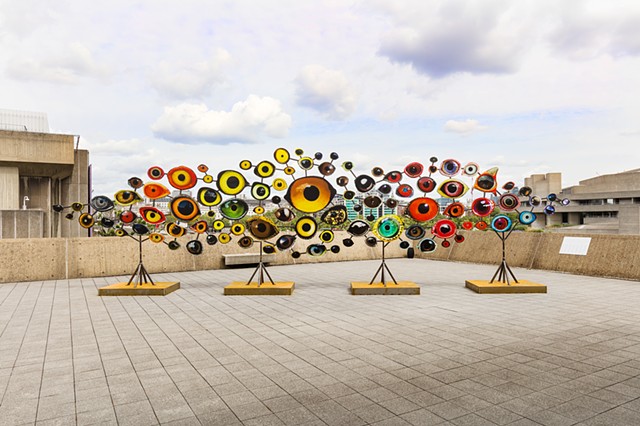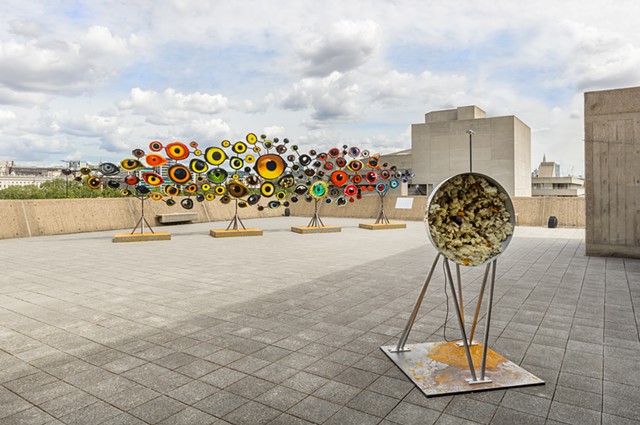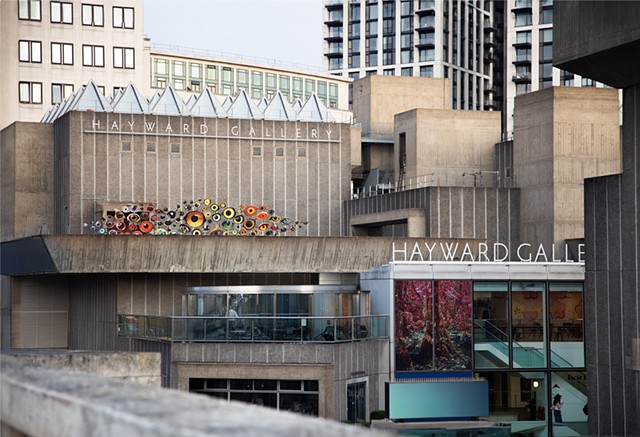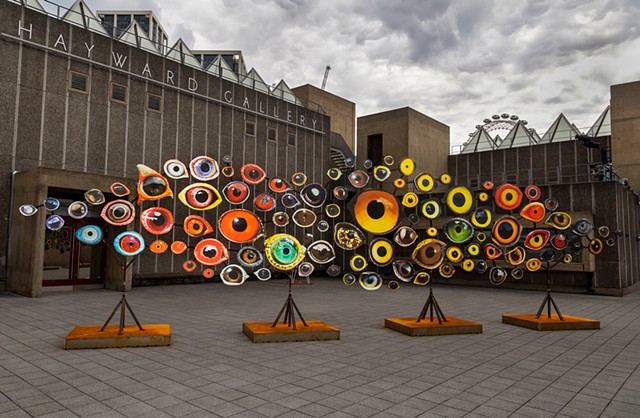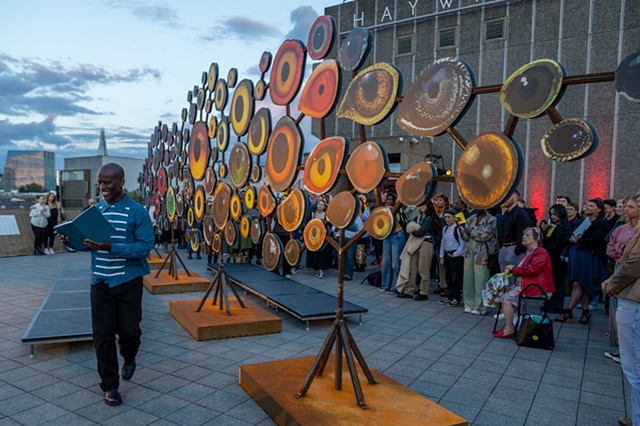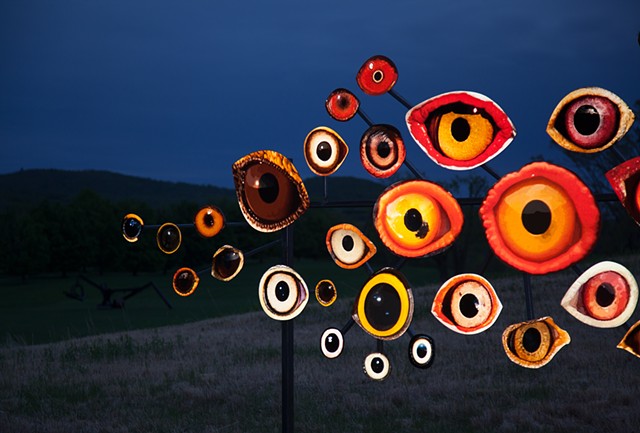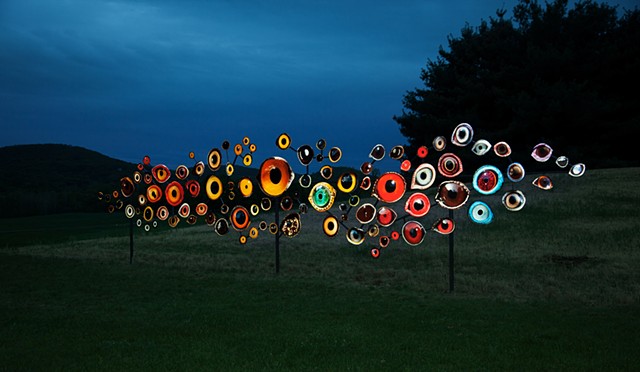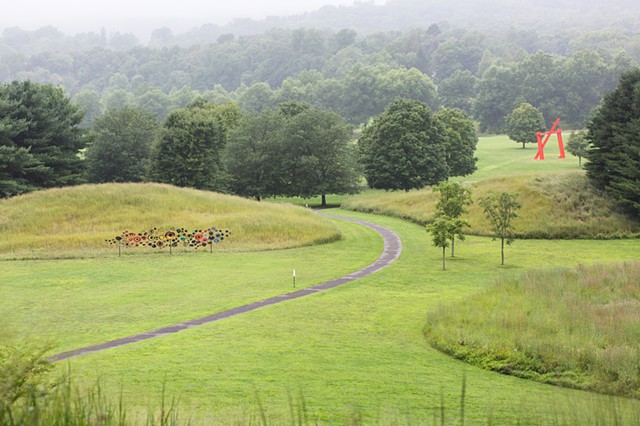Birds Watching
Birds Watching
Exhibitions/Permanent Installations:
Birds Watching I, 2018 was created for Storm King Art Center's Indicators: Artists on Climate Change, in partnership with NRDC, which ran from May–Nov 2018, and featured 100 U.S. climate-threatened species derived from Audubon's first report.
That work was reinstalled as a public sculpture in Chicago on the elevated 606 Bloomingdale Trail between St. Louis Ave. and Kimball Ave. and is fully-accessible via the Spaulding Ave. ramp. It opened Dec 15, 2018 where it is a permanent public artwork.
Birds Watching II, 2019 was created in July 2019 with the addition of site-specific E.U. and U.K. climate-threatened bird species for The Eden Project in Cornwall, UK, where it is part of their permanent collection.
In 2019, the project was re-imagined as a collage, using birds's eyes from John James Audubon's Birds of America, for the special issue of Audubon Magazine on climate change.
Birds Watching III, 2023 was created for the Hayward Gallery at the Southbank Centre in London, where it will be sited on their sculpture terrace overlooking the Waterloo bridge. The new work was created in collaboration with conservation scientists from the Zoological Society of London—an international, science-driven conservation charity—highlighting bird species whose survival they are working to ensure.
Birds Watching is a 40-foot long sculpture composed of a “flock” of one hundred reflective bird’s eyes mounted on aluminum, created initially for Storm King’s exhibition Indicators: Artists on Climate Change. The luminous eyes wrap a hill of native grasses in a ten-foot-high band of color, “gazing back” when illuminated. Each eye belongs to a species of bird considered threatened or endangered by climate change—creating a potent portrait of what we stand to lose.
Within the gaze of these many others, the work asks us to consider our own responsibility for climate change’s myriad effects on other beings. Have we allowed birds and other nonhumans—with their unique and wondrous lifeways—to become the sacrifice zones of extractive capitalism? As Surrealist André Breton suggested, in order to change ways of being, we must first change ways of seeing.
In that spirit, Birds Watching reminds us that truly seeing is a reciprocal act. Mass media imagery and omnipresent screens skew our sense of vision toward a one-way consumption, contributing to our feeling of being at a remove from the world. When we fall into this limited, non-participatory vision, what we see tends to confirm our biases and stereotypes—flattening other beings, like birds, into “things.” This objectifying gaze has become the default, but what about other gazes?—the gaze of mutual curiosity, the gaze of respect—or even of love? Can we re-enchant the way we see, bringing back its full depth of field—and depth of feeling—restoring to these non-human others their full being-ness?
And most potently, when our act of seeing is reciprocated by another being, this mutual gaze involves us in an active participation with and within our vibrant biosphere. Relearning the ability to look deeply at nature engages us in the enfolding, participatory act of living—re-weaving our entanglements with the rest of the natural world.
We cannot solely be spectators in this age of the Anthropocene, when our empathy for other beings—or lack thereof—has itself become an ecological force. Truly seeing can be a first step towards practicing a renewed ethos of mutualism and care.
Birds Watching reminds us that when we look at nature, nature looks back.
Selected Press for Dear Earth and Birds Watching III
From Art Plugged: "The crowning glory of the exhibition [Dear Earth at the Hayward Gallery] is a sound and sculpture installation by American interdisciplinary environmental artist and naturalist Jenny Kendler. Kendler collaborated with ZSL to create Birds Watching III, which features a flock of birds’ eyes, each belonging to a species of local and British birds endangered by the climate crisis. Visitors can experience their voice being translated into bird song. The soundtrack of birdsong and watching eyes of endangered species reminds us that if we don’t engage with and protect nature, it won’t survive, and neither will we."
From Think Pieces: "On the roof of the gallery, we are exposed to Jenny Kendler’s sculpture Birds Watching III. [...] With the eyes of the birds looking at us, the sculpture reverses the normative human-centred gaze by placing us as objects under the scrutiny of the birds threatened by our actions. This act of being looked at, of being scrutinised, allows us to be, as Kendler put it, “seated back in the natural world, to remember that we are not above or superior to nature, but deeply embedded in it. Our current society is founded on human supremacy, human exceptionalism, which allows for white supremacy, patriarchy, imperialism and so on.” She continued, “it is because of this that we are disconnected from the natural world around us, and this is the reason we feel lonely […] we feel a sense of loss, but we don’t know where it comes from.” Allowing ourselves to be the objects of our own destruction, rather than active subjects, is a radical intervention and a deeply humbling experience."
Selected Press for Indicators and Birds Watching I
• "Birds Watching" featured in the New Yorker
• Hyperallergic's coverage of "Indicators"
• Audubon.org interview about "Birds Watching" for their front-page
• Nuanced look at "Indicators" by a Huffington Post climate journalist
• "Birds Watching" & "Indicators" on NPR's WNYC
• "Indicators" announced in the New York Times
From Hyperallergic: "Among such works, Jenny Kendler’s crowd pleasing Birds Watching (2018) takes a particularly imaginative approach. Across the length of a 40-foot steel frame, the artist has affixed 100 images of variously sized and colored birds’ eyes — all species imperiled by climate change. At a glance, this cluster of concentric color looks like a whimsical shooting range or a floral bouquet. Upon further inspection, the viewer finds her or himself being viewed by a quizzical and accusatory collective stare. This horde of disembodied eyes, each printed on shiny reflective film, reverses the customary human-bird watcher/watched dynamic to incarnate something like an interspecies conscience."
